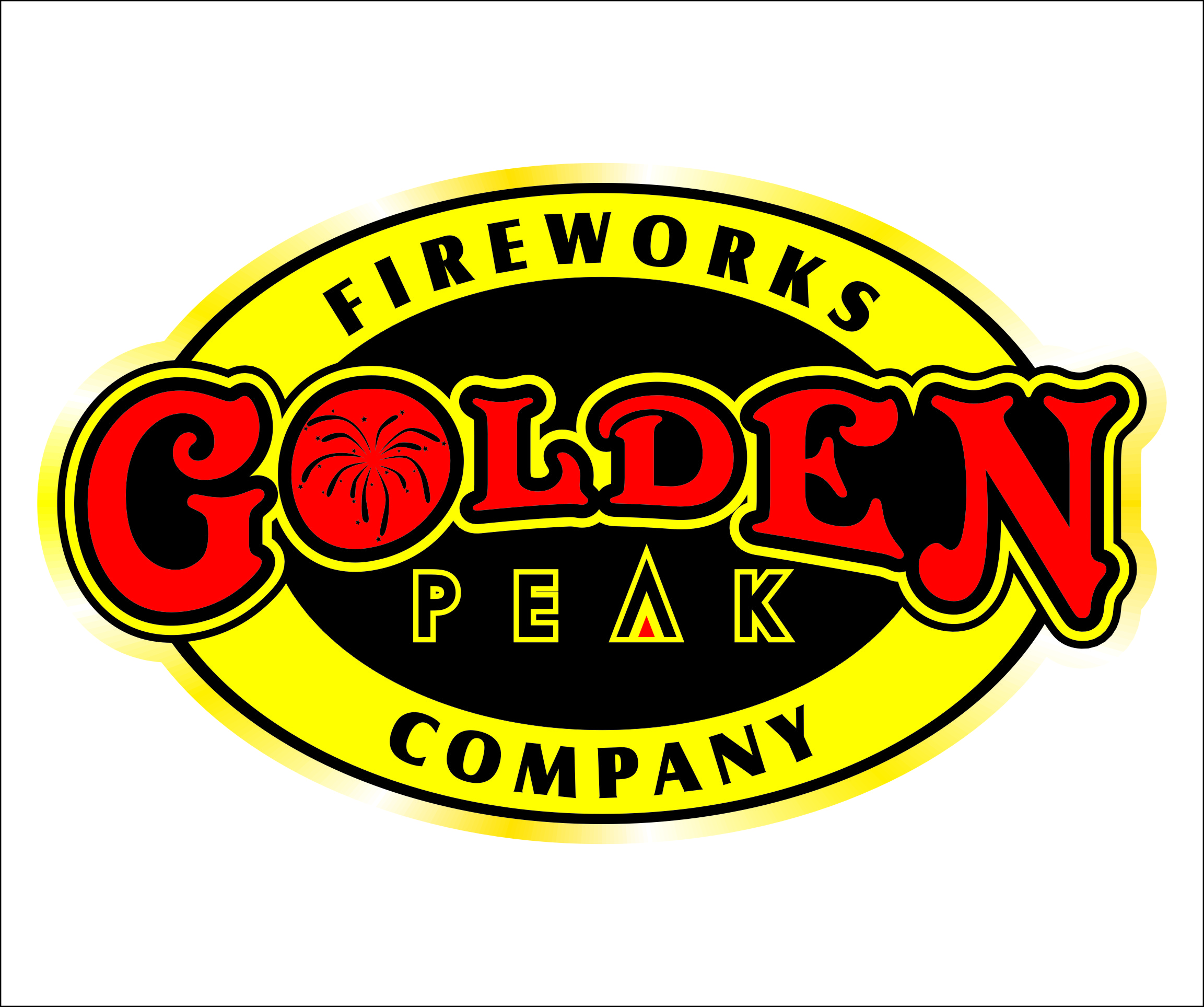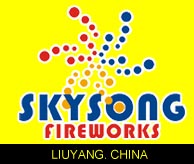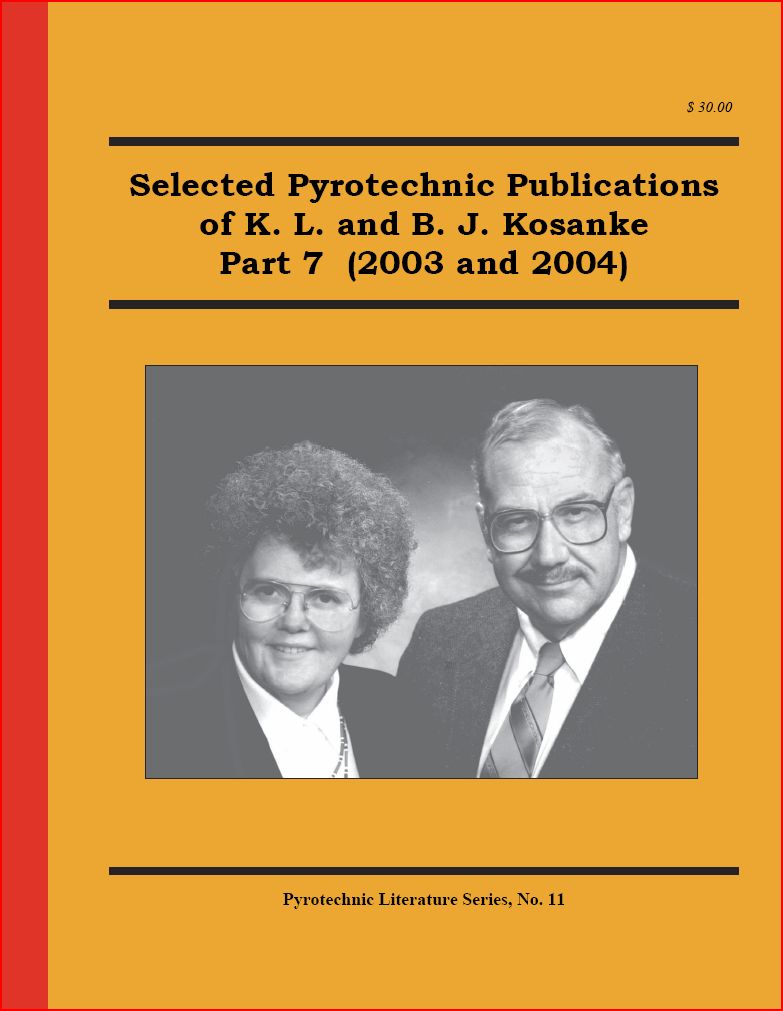K7 - Selected Pyro Publications of Kosankes Part 7
|
Titles and Abstracts (Part 7)Roman Candle Accident: Comet Characteristics This article is the second in a series addressing the nature, cause and course of a most horrific accident caused by a large-bore Roman candle. These articles are offered in the hope that through a sharing of what was learned in this case, similar accidents might be avoided in the future.
Pyrotechnic Burn Rate Measurement: Interstitial Flame Spread Rate Testing There are two general types of burning, sometimes described as parallel burning and propagative burning. In the previous article in this series, a method for determining parallel burn rate was discussed (strand testing), and a simplified method of testing under ambient conditions was suggested. In the current article, a method for determining one type of propagative burn rate (interstitial flame spread rate) is discussed.
Aerial Shell Augmentation Effects This article provides information about a method of augmenting an aerial shellÃ�ÃÃÃÃ�ÃÃÃ�ÃÃÃÃÃÃÃÃÃ�Ãà s aesthetic performance that is simple, high profit and widely appreciated by display sponsors. This method was first discussed many years ago by the authors as part of an article on electrically fired displays. In that article, these effects were described as parasitic firework effects. They were described in that way because the Ã�ÃÃÃÃ�ÃÃÃ�ÃÃÃÃÃÃÃÃÃ�Ãà parasiticÃ�ÃÃÃÃ�ÃÃÃ�ÃÃÃÃÃÃÃÃÃ�Ãà firework effects (small shells, mine stars and other small components) derived their lift energy from other Ã�ÃÃÃÃ�ÃÃÃ�ÃÃÃÃÃÃÃÃÃ�Ãà hostÃ�ÃÃÃÃ�ÃÃÃ�ÃÃÃÃÃÃÃÃÃ�Ãà aerial shells. In the present article, because it is more descriptive, these same effects will be called augmentation effects.
Feasibility Study on the Use of Nanoscale Thermites for Lead-Free Electric Matches Electric matches are used in the pyrotechnic industry to electrically initiate devices remotely and with precise timing. Unfortunately, most current commercial electric matches contain lead compounds, which when burned produce lead reaction products that may cause environmental pollution and contamination of firing areas. These lead compounds, namely lead thiocyanate, lead nitroresorcinate and lead tetroxide, are used in electric match pyrotechnic formulations because a small diameter resistive bridgewire can reliably initiate them. A possible alternative to lead-containing compounds is nanoscale thermite materials, otherwise known as Metastable Intermolecular Composite (MIC) materials. These super-thermite materials can be formulated to be sensitive to thermal stimuli, such as resistive heating. In the effort to produce a lead-free electric match, a feasibility study was performed using nanoscale aluminum and molybdenum trioxide mixtures in electric match formulations.
Characterization of Pyrotechnic Reaction Residue Particles by SEM / EDS Today the most reliable method for detecting gunshot residue is through the combined use of scanning electron microscopy (SEM) and energy dispersive spectroscopy (EDS). In recent years, this same methodology is beginning to find use in detecting and characterizing pyrotechnic reaction residue particles (PRRP) whether produced by explosion or burning. This is accomplished by collecting particulate samples from a surface in the immediate area of the pyrotechnic reaction. Suspect PRRP are identified by their morphology (typically 1 to 20 micron spheroidal particles) using a SEM and then analyzed for the elements they contain using X-ray EDS. This can help to identify the general type of pyrotechnic composition involved. Further, more extensive laboratory comparisons can be made using various known pyrotechnic formulations.
WARNING: Serious Product Malfunction In 2003 a fireworks display company experienced two serious malfunctions of a product. The items were 5-inch White Tiger Tail shells under the brand name of Flower Basket. These shells are spherical in shape and at the time were thought to be solid masses of comet composition, without a shell or other component inside the comet composition. The items were received in January of 2003. Forty of the comets were fired in a display. Two of these comets exploded with great violence within their HDPE mortars as they were being fired, destroying both the mortars and the wooden racks holding the mortars. (While there were no injuries in this instance, given the apparent power of the explosions, that certainly was a possibility.)
Flowerpots and Muzzle Breaks Flowerpot and muzzle break are descriptive terms for two types of star shell malfunctions. There can be serious safety consequences from these malfunctions, especially for manually fired displays. Some commonly held beliefs as to the cause of these malfunctions are challenged by the available data. This article summarizes some of that data and then draws inferences from that data.
Report on the Initial Testing of Suspect Tiger Tail Comets It was previously reported that two out of forty 5-inch White Tiger Tail comet shells had explosively malfunctioned upon firing, destroying their mortars and the racks that contained them. While traveling to conduct display safety training, it was arranged to visit the display company that experienced the problem with the comet shells. During that visit, the damaged mortars were inspected, photographed and sampled for pyrotechnic residues; the problem shells and some similar items were dissected, their components weighed and photographed; and fifty of the comet shells were test fired while being video taped. This article reports on that work.
The Effect of Reflected Blast Waves in HDPE Mortars A recent article discussed a problem with some comet shells exploding as they were being fired, and thus seriously damaging the HDPE mortars being used. Included in the article were photographs of the two mortars that had been damaged. In these photos, it was clear that, while both ends of the mortars received serious damage, the middle section of the mortars received less damage in one case and no damage in the other. This raised a question in the minds of some readers, how could a single explosion damage both ends of a mortar while leaving the middle of the mortar essentially undamaged? The purpose of this article is to address that question.
Electric Match Lead Splatters A study of performance characteristics of some common electric matches had been conducted. During the course of that study, a series of electron micrographs were made of the residues produced upon firing the electric matches. Those electric matches using lead mononitroresorcinate as a significant ingredient of their composition produced some interesting, albeit incredibly tiny, splatters of molten lead metal. In the thought that it might prove interesting to users of electric matches, four of these micrographs are shown in the accompanying figure.
Color Values and Spectra of the Principal Emitters in Colored Flames The emission spectra of many of the more important emitters in pyrotechnic flames were collected. For this purpose solutions and suspensions of sodium, potassium, calcium, strontium, barium and copper salts were aspirated into a propane gas flame as the excitation source. Performing instrument corrections and using appropriate data reduction strategies allowed the isolation of the individual spectra. Among these are the monochlorides and monohydroxides of strontium, calcium, barium and copper. The CIE color coordinates of the principal emitters were calculated from the isolated spectra. In addition, a table of normalized band and line intensities was produced for each of the successfully isolated emitting species.
Further Report on the Testing of Suspect Tiger Tail Comets In the hope of avoiding a serious accident, earlier issues of Fireworks Business carried a report of the powerfully explosive malfunctions of some tiger-tail comets, and then a brief report of an examination and initial testing of a number of the suspect comets. Since that time, samples from one of the suspect comet shells were provided for laboratory analysis. This article reports on the results of that analysis.
Shogun Electric Match Connectors The most common point of attachment of an electric match to a fireworks aerial shell is via the shell leader, and most commonly the installation of the electric match is performed by a display company when preparing for a display. Because of the difficulty of performing that operation with the safety shroud left in place, too often the shrouds are removed prior to their installation. Unfortunately, while removing the safety shroud is allowed under a US-DOT exemption, this greatly increases the likelihood of an accidental ignition. Fortunately, now there is a simple and effective solution to the problem; the Shogun Electric Match Connector.
The Effect of Intentionally Caused Fire Leaks into 2-1/4-Inch Consumer Fireworks Shells A series of experiments are being conducted to more definitively establish the difference between the causes of so-called flowerpots and muzzle breaks. Testing was performed to document the effect of firing small firework aerial shells after having intentionally provided fire leaks into those shells. The idea for this testing originated from a conversation that occurred during a break between paper presentations at the First International Symposium on Fireworks. At that time, the authors were engaged in research to determine the cause and mechanism of some types of aerial shell malfunctions. This work focused on the time taken for various size aerial shells to explode after the ignition of their contents and the time for those same size shells to exit a mortar after ignition of their lift charges. Based on this work, the authors had concluded that relatively minor fire leaks (through small holes and cracks) would be expected to preferentially produce muzzle breaks rather than flowerpots and that flowerpots must be the result of more substantial fire leaks into the shells. Part of the reason for the conversation was to solicit input regarding the authorsÃ�ÃÃÃÃ�ÃÃÃ�ÃÃÃÃÃÃÃÃÃ�Ãà work from two persons highly knowledgeable in the manufacture of aerial shells.
Typical Mortar Recoil Forces Produced When Firing Spherical Aerial Shells One of the more common requests for information regards the recoil force produced when aerial shells are fired from mortars. Generally the concern is whether some support structure (e.g., roof top, platform or barge deck) will safely accommodate the dynamic load produced as shells of various sizes are fired from mortars placed upon the support structure. Providing a precise answer can be a complex engineering problem, requiring information that is not readily available. However, providing reasonable estimates for the recoil forces produced by the firing of typically performing aerial shells is a relatively easy matter. This article provides those approximate values for typical 3- through 12- inch (75- through 300-mm) spherical aerial shell firings. (These values are only for single break spherical shells; they are not for cylindrical shells or for so-called stacked, double-bubble, or peanut spherical shells.)
Indoor Pyrotechnics-A Brief Cautionary Message The forensic science community has had a long-standing interest in the analysis of the residues deposited after the deployment of devices whose operation involves a controlled explosion. For example, testing for the residues of the compounds of lead, barium, and antimony, used in the primer of small-arms ammunitions, may be required on the hands and clothing of individuals to determine whether they may have discharged, or otherwise had contact with, a firearm. As an extension of research in the area of gunshot residue analysis, recent work dealing with the examination of residues from various pyrotechnic devices has revealed some trends in the chemical composition of the residues of pyrotechnic devices. A survey of the composition of the starting components and residues from 150 small, consumer grade pyrotechnic devices purchased in the United States revealed that more than 30% of the devices contained some proportion of lead, 5% contained antimony, and 80% contained barium. These devices included fountains, wheels, and ground spinners that are likely to be used in family fireworks displays in close proximity to the spectators.
Manual Firing Delay Times for Aerial Shells As used in this article, the definition of Ã�ÃÃÃÃ�ÃÃÃ�ÃÃÃÃÃÃÃÃÃ�Ãà manual firing delay timeÃ�ÃÃÃÃ�ÃÃÃ�ÃÃÃÃÃÃÃÃÃ�Ãà is the time interval between the manual ignition of the tip of the shell leader delay element and when the aerial shell fires from its mortar. This delay time is of interest in the context of the delay time requirement in the National Fire Protection AssociationÃ�ÃÃÃÃ�ÃÃÃ�ÃÃÃÃÃÃÃÃÃ�Ãà s Code for Fireworks Displays (NFPA- 1123).
A Brief Description of the Construction and Functioning of Common Electric Matches A simple description of the construction and the physical principles governing the function of common electric matches and some implications of these principles for testing and firing them are presented.
A Report on the Fireworks Accident at Carmel, Western Australia The investigation into an accident at Carmel, Western Australia in March 2002 found that the magnitude of explosions occurring in licensed and unlicensed storage areas was significantly greater than would have been expected from the UN hazard classification of items stored within them. Use of revised UN default classification tables for the items in storage, instead of the previous classification, goes toward accounting for the violence of the explosions. The official report into the accident makes a number of recommendations that are of direct international relevance, such as a minimum safety distance of 400 m (from residential housing or defined vulnerable facilities) for licensed UN Hazard Division 1.1 magazines regardless of mass of contents (above 50 kg minimum), removal of a concession that allows for the temporary storage of fireworks in unlicensed areas for up to 14 days prior to a display, the adoption of the UN default classification table throughout Western Australia and the importation of incorrectly classified fireworks to be made an offence.
As Defined in Regulation, What is Fireworks Flash Powder? Although widely used, the term Ã�ÃÃÃÃ�ÃÃÃ�ÃÃÃÃÃÃÃÃÃ�Ãà flash powderÃ�ÃÃÃÃ�ÃÃÃ�ÃÃÃÃÃÃÃÃÃ�Ãà is poorly defined; there is nothing even approaching universal agreement about exactly which pyrotechnic formulations are and are not fireworks flash powders. This would be of some concern under any circumstance; however, it is the use of the termÃ�ÃÃÃÃ�ÃÃÃ�ÃÃÃÃÃÃÃÃÃ�Ãà flash powderÃ�ÃÃÃÃ�ÃÃÃ�ÃÃÃÃÃÃÃÃÃ�Ãà in regulations that greatly magnifies the problem. One might expect that an agency choosing to use the term Ã�ÃÃÃÃ�ÃÃÃ�ÃÃÃÃÃÃÃÃÃ�Ãà flash powderÃ�ÃÃÃÃ�ÃÃÃ�ÃÃÃÃÃÃÃÃÃ�Ãà in their regulations would have a responsibility to provide a reasonably precise definition for it; if not providing a generally applicable definition, then at least a definition for use within the context of the regulations. Unfortunately, this is not the case.
An Interesting New Design???? It is difficult to argue that the quality of Chinese fireworks has not improved greatly over the past 25 years. However, that is not to say that on occasion, one still does not encounter quality related problems, sometimes so extreme that it is hard to believe. The photo in Figure 1 is of a 3-inch (75-mm) aerial shell and is such an example. (The authors encountered this shell several years ago, while working briefly in Australia.) Based on the location of the shellÃ�ÃÃÃÃ�ÃÃÃ�ÃÃÃÃÃÃÃÃÃ�Ãà s crossmatched time fuse and suspender ring, the lift cup has clearly been attached to the side of the aerial shell. One might suspect that this was an attempt at a cleaver new design, were it not for the fact that this shell would not fit into a 3-inch mortar, and that the other 71 shells in the case had been constructed normally. Before seeing this shell, who would have believed that such an incredibly obvious error could ever have been made by a worker attaching lift cups, and if made, how could it have escaped the notice of the worker packaging shells to make it through any quality control process!
Product Warning Display operators need to be aware of the potential for some tiger tail comets to produce extremely dangerous fallout. The problem was discovered only recently and was then investigated by the authors on a visit to the display companyÃ�ÃÃÃÃ�ÃÃÃ�ÃÃÃÃÃÃÃÃÃ�Ãà s facility. The shells in question are 4- and 5-inch (100- and 125-mm) White and Red Tiger Tail comets as shown overall in Figure 1. While all of the shells have the same basic labels, there were slight differences as noted in Table 1. However, in trying to determine whether any particular tiger tail comets have the problems found in the ones being discussed in this article, it is probably wise to consider that Chinese manufacturers frequently subcontract work and otherwise share production. Thus, it is possible that not all of the items labeled and appearing as shown in this article may have a problem, and it is also possible that items labeled and appearing differently may have the same problem described in this article.
From a Technical Standpoint, What is Flash Powder? In a recently published article on the regulatory definitions of firework flash powder it was concluded that none of those definitions provided sufficient information to objectively establish whether or not a pyrotechnic composition is a flash powder. That is to say, those definitions are all subjective to the extent that they depend on the intended use of the composition and none provide a quantifiable measure that can be used to determine whether a particular pyrotechnic composition is a flash powder. The purpose of the present article is to suggest a general approach that might be used as the basis for producing a quantitative definition of flash powder.
As is sometimes the case when doing research: A) one occasionally discovers something which was not being sought; B) the thing discovered then seems intuitively obvious and one is amazed (and a little embarrassed) not to have figured it out long ago; C) the thing discovered helps to answer some other previously seemingly inexplicable observations; and D) one finds there are some new questions for which no certain answer is immediately available. All four of these happened recently while the authors were investigating the size of hole in the casing of aerial shells (of various sizes) that is needed to produce a fire-leak sufficiently great to cause the shell to explode while it is still inside the mortar. During the course of those studies, it was found that a number of events, which visually appeared to definitely be flowerpots, were actually muzzle breaks.
When Is Wind Speed Excessive for the Safe Display of Fireworks While working on the 2006 edition of NFPA-1123 Code for Fireworks Display, the Technical Committee on Pyrotechnics of the National Fire Protection Association (NFPA) received a request for a Formal Interpretation regarding the 2000 edition of the code. In effect, a request for a Formal Interpretation is a request for the committee to provide clarification or a ruling regarding one or more paragraphs in the code. According to NFPA practice, a request for a Formal Interpretation must always be phrased in such a way that it can be answered either "yes" or "no". This article addresses that request for a Formal Interpretation and was written because: 1) the question being posed was reasonable and important; 2) a simple yes or no will not meet the needs of the requestor; and 3) to stimulate a discussion of the issue, such that the display fireworks industry might then provide guidance to the committee before they address the issue at their next committee meeting.
Warning Extremely Dangerous Directions for Firing The title of this very short article is, in effect, a direct quote from a label found on some display firework aerial shells. As it turns out, the label is more literally correct than might have been intended. Note that one of the instructions is to "LIGHT FUSE BEFORE PUT IN TO MORTAR" Few if any would argue that users should not be "warned" about such "extremely dangerous directions for firing". As regards this particular label, it would definitely seem to be a good thing that many inexperienced users of display fireworks fail to read (and in this case, rigorously follow) the use instructions accompanying them.
The Effect of Intentionally Caused Fire Leaks into 3-Inch Display Firework Aerial Shells This article is the second report on a series of tests to more definitively establish the difference between the causes of so-called flowerpots and muzzle breaks. A previous article reported on a similar study using 2-1/4 inch (57-mm) plastic aerial shells (formerly classed as consumer fireworks). The current article extends the earlier work by considering relatively high quality, although small, display firework shells. To conserve space and avoid needless repetition, some of the background and supporting information presented in the earlier article will not be repeated in the present article.
Fireworks Displays: When is Safe, Safe Enough? At a recent meeting of the National Fire Protection Association's Technical Committee on Pyrotechnics, there was a proposal to increase the site size requirement for public fireworks displays from the current 70 feet (21 m) to 100 feet (30.5 m) radius per the largest shell size in inches. It was the consensus of the committee that this was not needed because fireworks displays using the current distances were "safe enough". However, no one was able to substantiate their opinion with data. As part of that discussion the authors offered their own unsubstantiated opinion that it was likely that people were at a significantly greater risk while on the round trip drive to witness a fireworks display, than from the fireworks in the display. After offering some background information, this article presents a calculation of the comparative risks of driving to and attending a fireworks display, estimating that people are at least 7 times more likely to be killed or injured as a result of driving to attend a public display than they are from the fireworks in the public display.
The Effect on Mortars of Explosions within Them An earlier article that appeared a little over a year ago discussed one type of mortar bursting explosion. The article described a process whereby a sufficiently powerful explosion occurring internally near the muzzle of a high density polyethylene (HDPE) mortar would not only burst the top of the mortar, but could also burst the plugged end of the mortar, frequently leaving the middle section of the mortar fully intact. Since publishing that article, readers posed two questions: 1) do the conclusions of the earlier article apply equally to explosions occurring near the plugged end of mortars; and 2) do the conclusions of the earlier article apply equally to mortars made of other materials. The simple answers to the two questions are no and yes, respectively. However, before addressing these two questions, the current article will very briefly summarize the observations made in the earlier article. Reprint Information: Number of pages = 3. Download for free pp 801-803. |
 0 Items (Empty)
0 Items (Empty)












